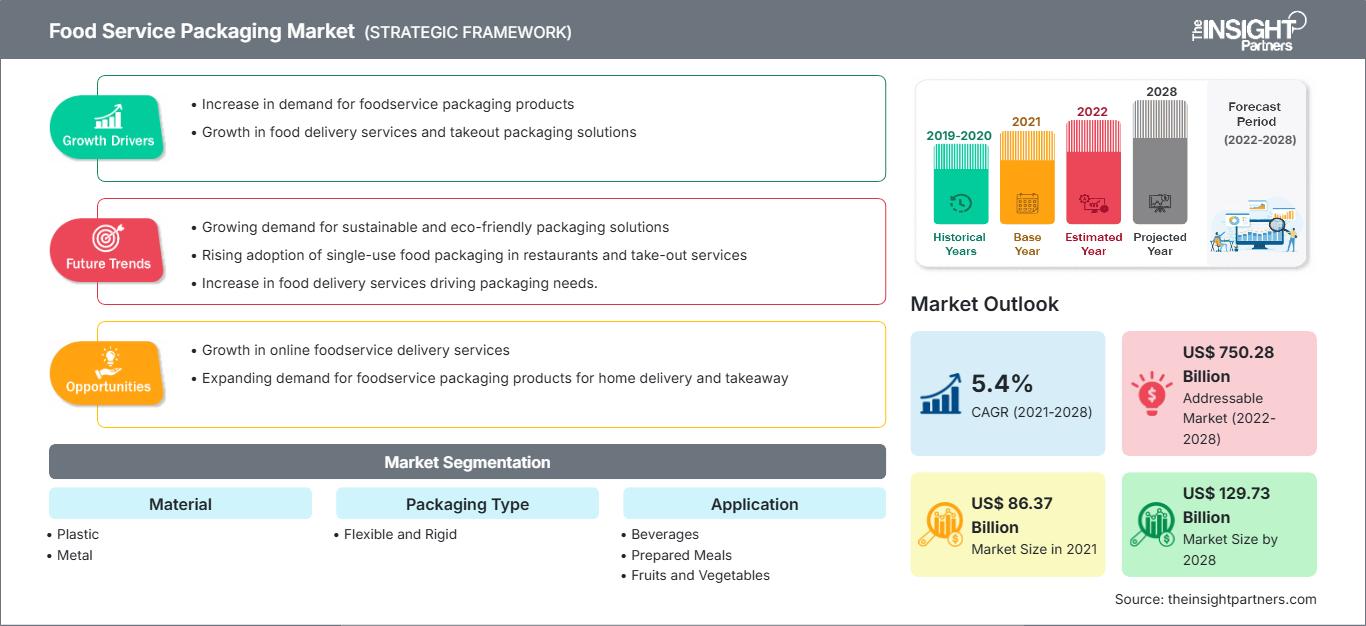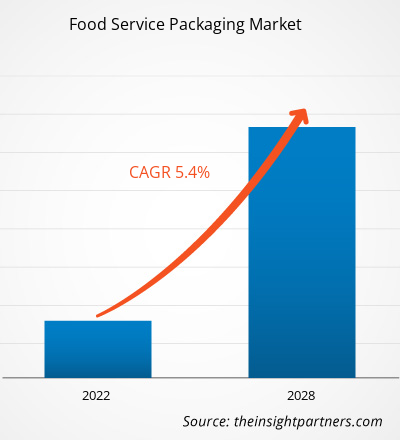[Rapport de recherche] Le marché de l'emballage pour la restauration était évalué à 86 372,08 millions de dollars américains en 2021 et devrait atteindre 129 728,93 millions de dollars américains d'ici 2028 ; il devrait croître à un TCAC de 5,4 % entre 2021 et 2028.
L'emballage pour la restauration comprend les produits utilisés pour le service ou l'emballage d'aliments et de boissons préparés dans les établissements de restauration sur place, à emporter et en livraison à domicile. Les produits d'emballage pour la restauration comprennent les gobelets pour boissons chaudes et froides, les assiettes, les plateaux, les bols, les sacs (à usage unique et à emporter), les contenants et couvercles, les couverts et ustensiles, les gobelets à glace, les gobelets à soupe et les porte-boissons. Ces produits protègent les produits alimentaires de la contamination causée par les micro-organismes, l'air et l'humidité.
En 2020, la région Asie-Pacifique détenait la plus grande part de chiffre d'affaires du marché mondial de l'emballage pour la restauration. La forte demande d'emballages pour la restauration, notamment de la part des restaurants à service complet, des cafés, etc., stimule principalement le marché de l'emballage pour la restauration en Asie-Pacifique. La commande de repas en ligne est en hausse dans la région grâce à la commodité offerte par ces plateformes, ce qui crée également une forte demande pour différents types d'emballages pour la restauration. La Chine et l'Inde comptent parmi les principaux pays d'Asie-Pacifique pour ce marché. En Inde, la tendance croissante à manger au restaurant parmi la population urbaine alimente la croissance du marché dans le pays.
Vous bénéficierez d’une personnalisation sur n’importe quel rapport - gratuitement - y compris des parties de ce rapport, ou une analyse au niveau du pays, un pack de données Excel, ainsi que de profiter d’offres exceptionnelles et de réductions pour les start-ups et les universités
Marché de l'emballage pour la restauration: Perspectives stratégiques

-
Obtenez les principales tendances clés du marché de ce rapport.Cet échantillon GRATUIT comprendra une analyse de données, allant des tendances du marché aux estimations et prévisions.
La pandémie de COVID-19 a affecté les économies et les industries de divers pays en raison des confinements, des interdictions de voyager et des fermetures d'entreprises. En 2020, plusieurs industries ont dû ralentir leurs activités en raison des perturbations des chaînes de valeur causées par la fermeture des frontières nationales et internationales. La pandémie a perturbé les processus de fabrication en raison des restrictions imposées par les autorités gouvernementales de divers pays. La propagation rapide de la COVID-19 a posé des défis sans précédent au secteur de la restauration. La fermeture des restaurants, des bars et des clubs en raison des politiques de distanciation sociale dans divers pays du monde a eu un impact négatif sur la demande de produits d'emballage pour la restauration.
Cependant, la croissance des plats à emporter et des commandes en ligne a créé des opportunités pour les restaurants. Les économies ont commencé à se relancer en 2021. Avec l'ouverture de restaurants, bars, clubs et autres points de vente de restauration, la demande de différents produits d'emballage pour la restauration continue d'augmenter.
Aperçu du marché : Prolifération des capacités de production de produits d'emballage
L'intérêt croissant des consommateurs pour des produits frais à durée de conservation prolongée et à qualité contrôlée crée une demande croissante de produits d'emballage alimentaire. Ce facteur aide les fabricants d'emballages alimentaires à concevoir et à développer de nouveaux emballages sûrs. De plus, la croissance démographique exerce une pression supplémentaire sur les secteurs de la production alimentaire pour qu'ils adoptent des solutions d'emballage améliorées afin de réduire le gaspillage alimentaire. Par conséquent, l'approche actuelle pour améliorer l'industrie alimentaire vise à réduire les dommages et le gaspillage alimentaires en réalisant des investissements importants dans le développement de technologies d'emballage alimentaires innovantes.
Aperçu des matériaux
En fonction des matériaux, le marché mondial de l'emballage pour la restauration est segmenté en plastique, métal et autres. Le segment du plastique détenait la plus grande part du marché mondial de l'emballage pour la restauration en 2020. L'emballage plastique est une forme d'emballage flexible. Il permet aux prestataires de services alimentaires de personnaliser la forme, le style et la taille de l'emballage selon les exigences de leurs clients. L'emballage en plastique est privilégié dans le secteur de la restauration en raison de sa légèreté. Ces avantages ont attiré des clients du secteur de la restauration. Par conséquent, le marché des emballages en plastique pour la restauration connaît un essor considérable.
Aperçu des applications
En fonction des applications, le marché mondial a été segmenté en boissons, plats préparés, fruits et légumes, boulangerie et confiserie, produits laitiers, etc.
.
Le segment des plats préparés détenait la plus grande part du marché mondial de l'emballage pour la restauration en 2020. Le plastique et l'aluminium biosourcés et biodégradables sont utilisés pour l'emballage des plats préparés.Scellage de barquettes, thermoformage, sachets stand-up, emballages stérilisables et Des sachets, des boîtes auto-chauffantes et des films étirables sont utilisés, et ils permettent de personnaliser la présentation des aliments.Graphic Packaging International, LLC ; Amcor PLC ; Cambay Technopack Private Limited ; Huhtamaki Global ; AR Packaging ; WestRock Company ; Genpak, LLC ; Vegware Ltd ; BeGreen Packaging ; et Stora Enso comptent parmi les principaux acteurs du marché mondial de l'emballage pour la restauration. Ces acteurs privilégient constamment des stratégies telles que les investissements dans la recherche et le développement, le lancement de nouveaux produits et les fusions et acquisitions. Les acteurs du marché se concentrent sur la fourniture de produits de haute qualité pour répondre à la demande des clients.
Points forts du rapport
- Tendances progressives du secteur sur le marché de l'emballage pour la restauration afin d'aider les acteurs à développer des stratégies efficaces à long terme
- Stratégies de croissance adoptées par les marchés développés et en développement
- Analyse quantitative du marché de l'emballage pour la restauration de 2019 à 2028
- Estimation de la demande mondiale d'emballages pour la restauration
- Analyse des cinq forces de Porter pour illustrer l'efficacité des acheteurs et des fournisseurs opérant dans le secteur
- Évolutions récentes pour comprendre le scénario concurrentiel du marché
- Tendances et perspectives du marché, ainsi que facteurs qui stimulent et freinent la croissance du marché de l'emballage pour la restauration
- Aide à la prise de décision en mettant en évidence les stratégies de marché qui sous-tendent l'intérêt commercial et conduisent à la croissance du marché
- Taille du marché de l'emballage pour la restauration à différents niveaux
- Aperçu détaillé et segmentation du marché, ainsi que la dynamique de l'industrie de l'emballage de services alimentaires
- Taille du marché de l'emballage de services alimentaires dans diverses régions avec des opportunités de croissance prometteuses
Aperçu régional du marché de l'emballage pour la restauration
Les tendances régionales et les facteurs influençant le marché de l'emballage pour la restauration tout au long de la période de prévision ont été analysés en détail par les analystes de The Insight Partners. Cette section aborde également les segments et la géographie du marché de l'emballage pour la restauration en Amérique du Nord, en Europe, en Asie-Pacifique, au Moyen-Orient et en Afrique, ainsi qu'en Amérique du Sud et en Amérique centrale.
Portée du rapport sur le marché de l'emballage pour la restauration
| Attribut de rapport | Détails |
|---|---|
| Taille du marché en 2021 | US$ 86.37 Billion |
| Taille du marché par 2028 | US$ 129.73 Billion |
| TCAC mondial (2021 - 2028) | 5.4% |
| Données historiques | 2019-2020 |
| Période de prévision | 2022-2028 |
| Segments couverts |
By Matériau
|
| Régions et pays couverts |
Amérique du Nord
|
| Leaders du marché et profils d'entreprises clés |
|
Densité des acteurs du marché de l'emballage pour la restauration : comprendre son impact sur la dynamique commerciale
Le marché de l'emballage pour la restauration connaît une croissance rapide, portée par une demande croissante des utilisateurs finaux, due à des facteurs tels que l'évolution des préférences des consommateurs, les avancées technologiques et une meilleure connaissance des avantages du produit. Face à cette demande croissante, les entreprises élargissent leur offre, innovent pour répondre aux besoins des consommateurs et capitalisent sur les nouvelles tendances, ce qui alimente la croissance du marché.

- Obtenez le Marché de l'emballage pour la restauration Aperçu des principaux acteurs clés
- Analyse historique (2 ans), année de base, prévision (7 ans) avec TCAC
- Analyse PEST et SWOT
- Taille du marché Valeur / Volume - Mondial, Régional, Pays
- Industrie et paysage concurrentiel
- Ensemble de données Excel
Rapports récents
Rapports connexes
Témoignages
Raison d'acheter
- Prise de décision éclairée
- Compréhension de la dynamique du marché
- Analyse concurrentielle
- Connaissances clients
- Prévisions de marché
- Atténuation des risques
- Planification stratégique
- Justification des investissements
- Identification des marchés émergents
- Amélioration des stratégies marketing
- Amélioration de l'efficacité opérationnelle
- Alignement sur les tendances réglementaires






















 Obtenez un échantillon gratuit pour - Marché de l'emballage pour la restauration
Obtenez un échantillon gratuit pour - Marché de l'emballage pour la restauration